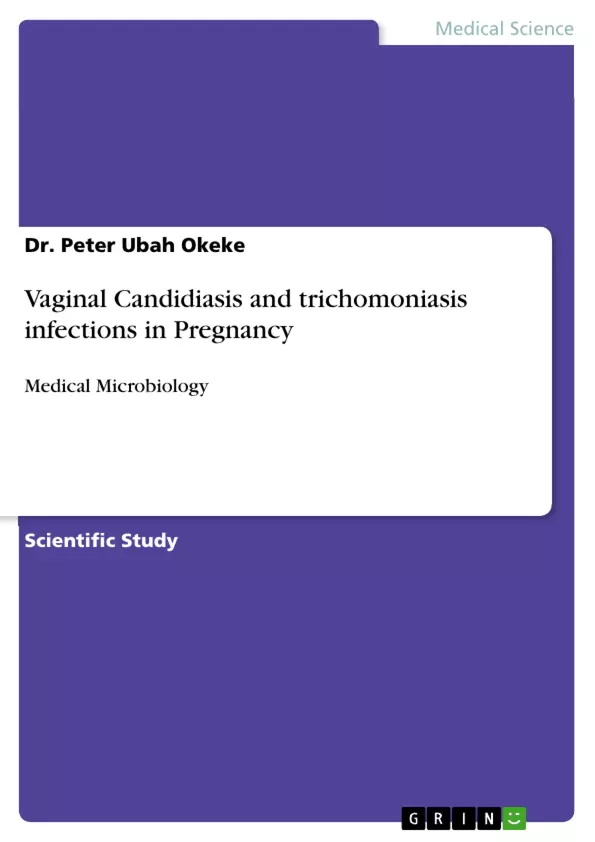A hundred and twenty-seven (127) pregnant women performed high vaginal swab (HVS) tests between the months of May to July, 2013, the age range of the pregnant women studied were from 13 to 45 years old. The specimen were studied for candida species and trichomonas vaginalis infections using wet mount or direct examination sometimes using10% Potassium hydroxide (KOH) , and gram stain techniques were applied to all the samples. They results of 21.26 % was obtained for candida species, while 6.3% was infected with trichomonas vaginalis. The study observed that the infection rate of candida species among the pregnant women was statistically significant to that of trichomonas vaginalis, considering P≤ 0.05. The co-infection rate (the infection of candida species and trichomonas vaginalis together) of the study was 0.79%. The primigravidae recorded 59 (46.46%) and multigravidae recorded 68 (53.54%), the infection of candida species of 28.8% was observed among primigravidae, while trichomonas vaginalis was 10.17%, also among primigravidae, the multigravidae registered 14.71% of candida species infection and trichomonas vaginalis was 2.94%. Therefore, the primigravidae were more infected with candida species and trichomonas vaginalis than multigravidae. The age groups of 13 to 25 years of the pregnant women were mostly infected by candida species (25.93%) and trichomonas vaginalis infection was 7.41%. The pregnant mothers at third trimester (27 to 40 weeks) were mostly attacked, making a prevalence rate of 23.81% of candida species, while trichomonas vaginalis was 9.52%.
The conclusion was that contributing factors such as douching should be avoided; indiscriminate use of antibiotics without medical supervision, and education of the pregnant women using various forms, stressing the importance of prevention and control strategies should be implemented.
Keywords: Vaginal candidiasis, Trichomoniasis, Pregnant, Women, Cape Verde.
Inhaltsverzeichnis (Table of Contents)
- Abstract
- Objective
- Introduction and literature review
- Methodology
- Collection of specimens
- Discussion
- Conclusion
- References
- Appendix
Zielsetzung und Themenschwerpunkte (Objectives and Key Themes)
This research aims to determine the prevalence of vaginal candidiasis and trichomoniasis infections among pregnant women.
- Prevalence of candidiasis and trichomoniasis infections in pregnant women
- Risk factors associated with these infections during pregnancy
- Impact of these infections on maternal and fetal health
- Comparison of infection rates between primigravidae and multigravidae
- Influence of age and gestational trimester on infection rates
Zusammenfassung der Kapitel (Chapter Summaries)
- Abstract: Provides an overview of the research findings, including the prevalence rates of candidiasis and trichomoniasis infections in pregnant women.
- Objective: States the clear objective of the study - to determine the frequency of candidiasis and trichomoniasis infections in pregnant women.
- Introduction and literature review: Discusses the prevalence and impact of vaginal candidiasis and trichomoniasis infections among women, focusing on the predisposing factors and symptoms associated with these conditions. It also explores the influence of pregnancy on these infections, highlighting hormonal changes and their effect on the vaginal flora.
- Methodology: Describes the methods used to collect and analyze data, including the type of specimens collected, the laboratory techniques employed, and the statistical analysis performed.
- Collection of specimens: Outlines the process of specimen collection from pregnant women, including the time frame and the number of participants involved.
Schlüsselwörter (Keywords)
The study focuses on vaginal candidiasis, trichomoniasis, pregnant women, infection prevalence, risk factors, maternal and fetal health, primigravidae, multigravidae, age, gestational trimester, and Cape Verde.
- Arbeit zitieren
- Dr. Peter Ubah Okeke (Autor:in), 2013, Vaginal Candidiasis and trichomoniasis infections in Pregnancy, München, GRIN Verlag, https://www.grin.com/document/231669



